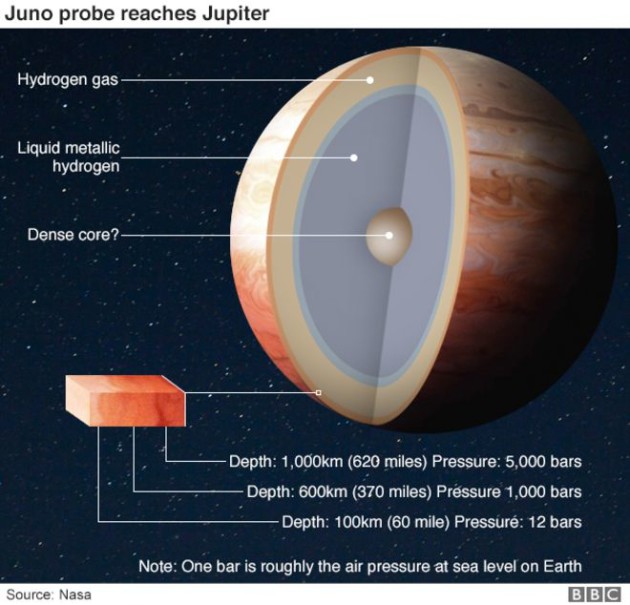Juno probe returns close-up Jupiter pictures
 Sept. 03: The US space agency (NASA) has released spectacular new images of Jupiter acquired by its Juno probe.
Sept. 03: The US space agency (NASA) has released spectacular new images of Jupiter acquired by its Juno probe.
The pictures show the swirling clouds of the gas giant at both its poles – views that no previous mission has managed to acquire in such detail.
Juno captured the data last weekend as it made its first close approach to the planet since going into orbit in July.
The flyby took the spacecraft just 4,200km above Jupiter’s multi-coloured atmosphere.
The 6MB of data downlinked to Earth from the encounter is still being analysed, but principal investigator Scott Bolton said new things were already obvious.
“First glimpse of Jupiter’s north pole, and it looks like nothing we have seen or imagined before. It’s bluer in colour up there than other parts of the planet, and there are a lot of storms,” the Southwest Research Institute scientist explained in a Nasa statement.
“There is no sign of the latitudinal bands or zones and belts that we are used to – this image is hardly recognisable as Jupiter.
“We’re seeing signs that the clouds have shadows, possibly indicating that the clouds are at a higher altitude than other features.”
Jonathan Nichols from the University of Leicester, UK, is a member of the Juno mission’s science team.
He told the BBC that his colleagues were bowled over when they first saw the pictures: “The team’s reaction was amazement. ‘Look at these images; they are coming from Jupiter; we’re flying over the pole for the first time!’ It’s just jaw-dropping.”
When the Juno probe arrived at Jupiter in July, its instruments and camera were switched off.
It had to perform a critical rocket manoeuvre to get into orbit – and engineers did not want the complication of taking pretty pictures at the same time. But after successfully turning around the planet, Juno booted up its other systems, and last Saturday’s return pass was the first opportunity to get a good look at the gaseous world.
The probe’s Jovian Infrared Auroral Mapper (JIRAM) has acquired unique views of Jupiter’s southern aurora.
Earth telescopes have tried but failed to get such images.
And Juno’s Radio/Plasma Wave Experiment (Waves) has recorded the blizzard of particles moving through the planet’s super-strong magnetic field.
Juno’s quest is to investigate the secrets of the Solar System by explaining the origin and evolution of its biggest planet.
The spacecraft’s remote sensing instruments will look down into the giant’s many layers and measure their composition, temperature, motion and other properties.
We should finally discover whether Jupiter has a solid core or if its gas merely compresses to an ever denser state all the way to the centre.
We will also get new information on the famous Great Red Spot – the colossal storm that has raged on Jupiter for hundreds of years. Juno will tell us how deep its roots go.
And Dr Nichols said Jupiter was a wonderful laboratory to try to understand even more distant places.
“We can go to Jupiter and kick the tyres to see how it works, but that then gives us some insights on lots of other objects in the Universe.
“We can use Jupiter as an analogue for things like brown dwarfs and exoplanets – basically, any fast-rotating body with a magnetic field can be modelled in some way like Jupiter.”
The spacecraft is currently flying on an ellipse around Jupiter that takes 53 days to complete. Its next close approach is due on 19 October, when the probe will fire its main engine to tighten the circuit to just 14 days.
This configuration will then be held until February 2018 when the spacecraft will be commanded to make a destructive dive into Jupiter’s atmosphere.
By that stage, however, scientists hope to have built a formidable data-set to help answer their most pressing questions about this vast world.bbc.com
